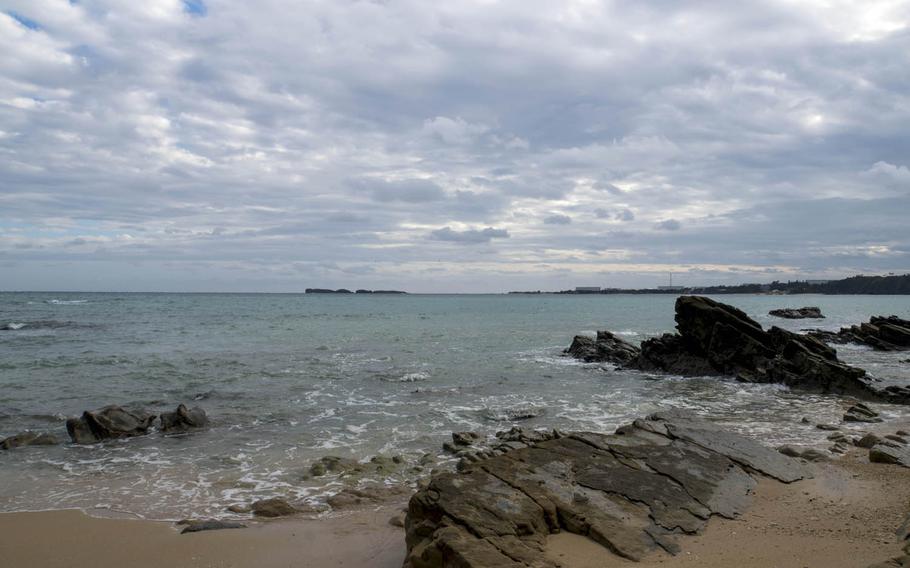
Parts of Oura Bay, Okinawa, with Camp Schwab in the distance, is seen in December 2016. (Jessica Bidwell/Stars and Stripes)
CAMP FOSTER, Okinawa — Okinawa prefecture filed suit against Japan’s central government this week in a fresh attempt to block the relocation of Marine Corps Air Station Futenma to a remote part of the island.
The basis of the lawsuit, which was filed Monday in Naha District Court, is a permit that expired March 31 that allowed for the breaking of the coral reef in Oura Bay at Henoko to make way for a new runway at Camp Schwab. The work is seen as detrimental to local fishermen.
Central government officials said they don’t need to renew the permit, which would have to be signed by the prefecture’s anti-base Gov. Takeshi Onaga, because the local fishermen’s organization relinquished their rights to the area.
The prefecture also filed an injunction to suspend the ongoing construction work while the litigation is pending.
Once the runway is built at Schwab, plans call for Futenma’s air assets to be relocated to Henoko in the remote northern recesses of Okinawa. Futenma, which is in a densely populated urban area in central Okinawa, would then be shuttered and handed back to Okinawa.
“The Okinawa Defense Bureau did not respond to repeated administrative guidance by Okinawa prefecture and began work to protect the shore for the construction work to build the relocation facility for Futenma air base and it is clear that it will conduct work such as destroying reefs,” Onaga told reporters on Monday. He went on to criticize Tokyo for ignoring the feelings of the Okinawan people.
The lawsuit is the latest attempt by Onaga to stop the relocation of Futenma’s air operations to Henoko. Construction for the relocation began in August 2014, but was halted in March 2016 after Onaga revoked a permit to fill in the sea for the runway.
In December, the Fukuoka High Court struck down the revocation in a decision that was later upheld by Japan’s Supreme Court. Construction work then resumed.
Tokyo officials declined to comment on the suit this week, but vowed to push ahead with construction.
“Based on the settlement reached last year and the decision by the Supreme Court, we will soundly move forward with this project,” Japanese Defense Minister Tomomi Inada said Tuesday.
Chief Cabinet Secretary Yoshihide Suga said Okinawa’s lawsuit goes against the spirit of the settlement reached last year. He added that both sides pledged to follow the court’s decision.
“Governor Onaga stated in the hearing that he will follow the court’s decision as the leader of a public administration,” he told reporters on Monday.
Suga added that appropriate measures were being taken to safeguard both the environment and the lives of local residents.
Onaga said the decision should be conducted based on laws.
“The previous Supreme Court decision was a decision on one process involving the permission of reclamation work, and even though a decision was made by the Supreme Court, it does not mean that processes after it can be conducted freely,” he said at Monday’s press conference.
The latest lawsuit comes as no surprise, after word of the governor’s intention to file leaked in May. Onaga then sought approval from the prefectural assembly.
In December, with Japan’s Supreme Court expected to uphold the lower court ruling that handed defeat to Onaga, he released a 13-point plan that he intended to follow to further block the relocation. Three of the points involved permits that may cross his desk.
This week, prefectural officials vowed to continue to check each administrative step taken in the approval process for the relocation in hopes that mistakes could be identified and used to further block the project.
The relocation was first floated in the mid-1990s over safety concerns involving Futenma and its close proximity to homes and businesses. The plans picked up steam after the rape of a 12-year-old girl by three U.S. servicemembers.
Japanese and American lawmakers agreed to shutter the base and move Marine air operations, but they stated keeping them on the island was the only viable option. That decision led to protests that continue to this day.
Onaga was elected in 2014 after campaigning on stopping the relocation and expelling the Marine tilt-rotor MV-22 Osprey. He has not been successful in either pursuit.
The protest movement seeking to stop the relocation is relatively small but has the popular support of a majority of citizens, according to polls. Protest leaders have called for the air assets to be moved off Okinawa to decrease the burden on the island, which hosts approximately half of all U.S. troops stationed in Japan.
However, Marine Corps officials have said the aircraft need to be where the Marines are, in case a quick response is required on the Korean peninsula.